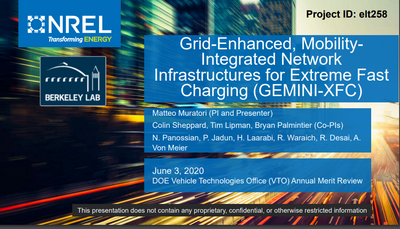July 10, 2020
 The Transportation Sustainability Research Center and Berkeley Lab are working with the National Renewable Energy Laboratory (NREL) on a new project for the DOE Vehicle Technologies Office called the Grid Enhanced Mobility-Integrated Network Infrastructures (GEMINI-XFC) Project.
The Transportation Sustainability Research Center and Berkeley Lab are working with the National Renewable Energy Laboratory (NREL) on a new project for the DOE Vehicle Technologies Office called the Grid Enhanced Mobility-Integrated Network Infrastructures (GEMINI-XFC) Project. This is a collaborative effort between NREL and LBNL to study high power level EV charging and the integration of two complex modeling frameworks: 1) the Behavior Energy Autonomy and Mobility (BEAM) transportation model at LBNL and the HELICS and OpenDSS distribution-level grid modeling capabilities at NREL.
The project, led at TSRC by Co-Director Timothy Lipman, is examining the extreme fast charging (XFC) impacts of future EV fleets on local distribution grids in the San Francisco Bay Area, culminating with a region-wide analysis. XFC is defined in the GEMINI project as individual charge points of 250+ kW, and also charging depots with 1+ MW of coincident load at the site level.
The project involves developing a complex network of interactive logic controllers and subsequent analysis in this now combined modeling framework, to respond to grid operational conditions, prices, and other signals and to manage the charging of future fleets of personally-owned and autonomous personal and ride-hail EVs in a large urban region. The project is led by Matteo Muratori at NREL with Co-PIs Bryan Palmintier (NREL), Timothy Lipman (TSRC/LBNL), and Colin Sheppard (LBNL), along with a team of NREL and LBNL research staff. EECS Graduate Student Researcher Keith Moffat will join the research team in late Summer.
